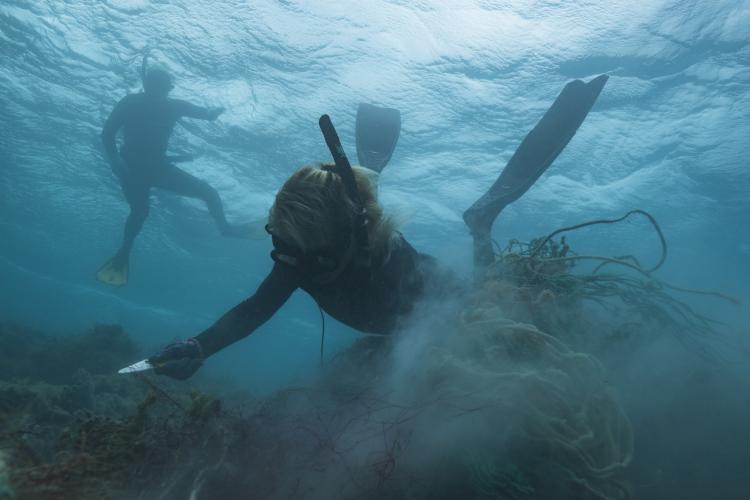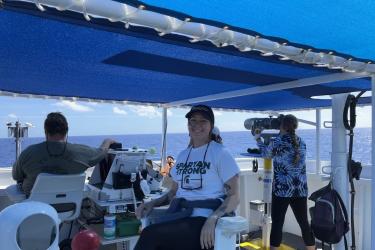Cleaning the salt crystals off my sunglasses, the wind is gusting and the flag is beginning to fray at its edges. This is day three of marine debris removal operations at Pearl and Hermes Atoll in the Northwestern Hawaiian Islands.

The wave chop comes off the bow of the zodiac inflatable boat and showers the crew as we cross the channel to begin our day of work.

At the far east end of the atoll, the fringing reef surfaces enough to break the waves. When you look off into the seeming unending blue water, you can see large explosions of white seemingly out of nowhere in the distance. That surf is the only way you can see the edges of the atoll.
Although the aerial footage of Pearl and Hermes makes the water look very clear, the visibility is actually fairly murky, making the large, curious fish sneaking up on you a little bit frightening and curious fish always come by.
We have been working hard each day to swim the maze of patch reefs that make up Pearl and Hermes Atoll to find and carefully remove derelict fishing nets. So far, we have cleared 13,286 kilograms or roughly 30,000 pounds of net off the reef. It is important to remove these nets for a variety of reasons: nets can kill the coral by shading the reef and by rolling on top of the corals and ripping them out. Nets are also huge entanglement hazards for marine life. The islands and atolls of the Northwestern Hawaiian Islands serve as a breeding ground and habitat for many marine animals, including many of Hawaii's endangered species like hawksbill sea turtles and Hawaiian monk seals.

The wildlife is always amazing up here. Today marked the team's first tiger shark sighting and it is always a treat to see such a large, beautiful animal, especially when you are viewing it from a safe distance on the boat.
We also found our first entangled sea turtle. We saw a net floating on the surface in the distance, and completed the rest of our survey area before approaching it. We soon found that, within the net, what looked like a buoy from above was actually a turtle's shell, she had a lot of algae growing on her. It looked like she had been entangled in the net there for a few weeks. Unfortunately, when we removed the net from her front flipper, we found that the line had cut into her skin, the bone was exposed, and her flipper was already deteriorating. Luckily, we know sea turtles can often live with only one flipper. We are really rooting for her survival. After we freed her from the net, she swam to a little cave in the reef and took some time to get some much-needed rest.

As for the marine debris team, we prepare for our next day of operations by sharpening our knives and entering data for the day.
That's it for now, headed off to engrave satellite buoys to place on several of the nets that we aren't able to collect from the atoll because we reached capacity. Instead, these nets will become part of a marine debris study. We will track them over the next few years to study their movements around Pearl and Hermes and possibly the Pacific.
Meet the Bloggers

Kristen Kelly
KK grew up in the lakes of Vermont with two older brothers who teased her about lake sharks and her purple nail polish. After a summer of living in fear, she went to the library to research their claims there, she found an entire new world filled with marine life (and the freedom to paint her nails purple). After that day, her answer to the question, What are you going to be when you grow up? was always, a marine biologist. She moved to Hawai'i after graduating from the University of New England. This will be her fifth marine debris expedition in the Northwestern Hawaiian Islands. KK hopes you can follow the stories, view the photos, participate in some activities, and be inspired by this plastics issue to change how you live and motivate those around you.

Mike Pamatat
Before joining the team this year, Mike worked at the University of Hawaii's dive safety program. He assisted with various underwater projects around the Big Island, including structure from motion photogrammetry. He also dabbled in the world of mathematics where he examined the properties of phylogenetic tree space. Mike has worked in various marine environments and is super pumped to get back in the field and contribute to this marine debris mission.
Follow us
Follow the team as we travel to the islands and atolls of the Northwestern Hawaiian Islands with photos and updates on our Story Map.
Partners
NOAA Fisheries marine debris project in the Pacific Islands region is supported by NOAA (Pacific Islands Fisheries Science Center, Pacific Islands Regional Office, Marine Debris Program, National Marine Sanctuaries, and the Damage Assessment Remediation and Restoration Program) in partnership with the University of Hawaii's Joint Institute for Marine and Atmospheric Research, National Fish and Wildlife Foundation, U.S. Fish and Wildlife Service, Midway Atoll National Wildlife Refuge, the State of Hawaii’s Department of Land and Natural Resources, and the Papahānaumokuākea Marine National Monument.

